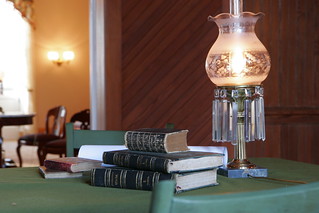But this sort of dreaming can't stay locked in drawers, left on the backs of envelopes and stuffed away in digital filing cabinets back at work.
So here's a peek at what I'm presenting. It's a way of visualizing impacts, Civil War and otherwise, on the world around us.
 |
| Trains and Horses, integrally tied. / PD LOC - NHNYCW |
The logistics of the American Civil War were staggering. For example, the Army of the Potomac, in 1863, had 69 individual artillery batteries scattered among its six different Corps. Each of these batteries had, on average, six cannon. These cannon and their limbers were typically towed by 6 horses, giving the typical battery around 36 horses.
The guidelines for field artillery in the United States army called for each horse to receive 14 pounds of hay and 12 pounds of grain (oats, corn or barley) per day. If fed to military guidelines, one battery of field artillery required 504 pounds of hay and 432 pounds of grain each day.
Within the Army of the Potomac, if fed to military guidelines, the entire cadre of field artillery required 34,776 pounds of hay and 29,808 pounds of grain each day. For a sense of scale, a typical modern acre of corn yields about 8,000 pounds per year. A typical modern acre of hay yields between 8,000 to 12,000 pounds per year. Every day of the war, the Army of the Potomac’s artillery required about 3 ½ acres of hay and 3 ½ acres of grain.
If fed to army specifications, in a year, the artillery batteries of the Army of the Potomac would eat 10,879,920 pounds of corn and 12,693,240 pounds of hay. This is 5,439 tons of corn and 6,347 tons of hay each year of the four year war.
The armies in the field often foraged for supplies from the land, using the crops and stores of the country they occupied to feed themselves and their animals. This mass of supply, however, simply was not available. Across the entire state of Virginia in 1860, the state where the Army of the Potomac based much of its operations, cornfields did yield roughly 2 billion pounds (or 1 million tons) of corn. But two armies vied for resources in Virginia, and the theatre of operations encompassed very little of the state in the larger scope.
Suppose that even just half of the fodder required by the Army of the Potomac’s artillery (21,756 tons of corn and 25,388 tons of hay over the course of the war) was shipped to the east from the western states, most likely from a large hub like Chicago. Chicago is around 700 miles from Washington, D.C. by rail.
The amount of coal required to haul one ton of freight one mile with a mid-nineteenth century steam engine was around 6-8 ounces. Hauling 47,143 tons of freight 450 miles requires 198,000,600 ounces or 12,375,038 pounds of coal.
Burning coal emits CO2 gas at a rate of 1/2.93. For every 1 pound of coal burned, 2.93 pounds of CO2 gas are produced. If northern steam engines burned 12,375,038 pounds of coal to haul feed to the Army of the Potomac’s artillery, they produced 36,258,861 pounds of CO2 gas in a four year period.
Today’s coal power plants produce about 3,941,865,250,000 pounds of CO2 gas per year.
There are about 600 plants in the nation. If each produces roughly the same amount of CO2, this works out to 6,569,775,420 pounds per plant, per year. A plant, running 24/7, 365 days a year, produces 17,999,384 pounds a day or 749,974 pounds per hour.
Meaning, the Army of the Potomac’s Artillery’s horses fodder for the entire four years of war required a transport carbon cost roughly equal to just 48 hours of power production from a modern coal burning power plant.
This work contains material based upon or wholly the work of a National Park Service employee, created during the course of official duties. As a work of a federal government agency, such work is in the public domain and free to be redistributed, reused or remixed by anyone for any purpose.












